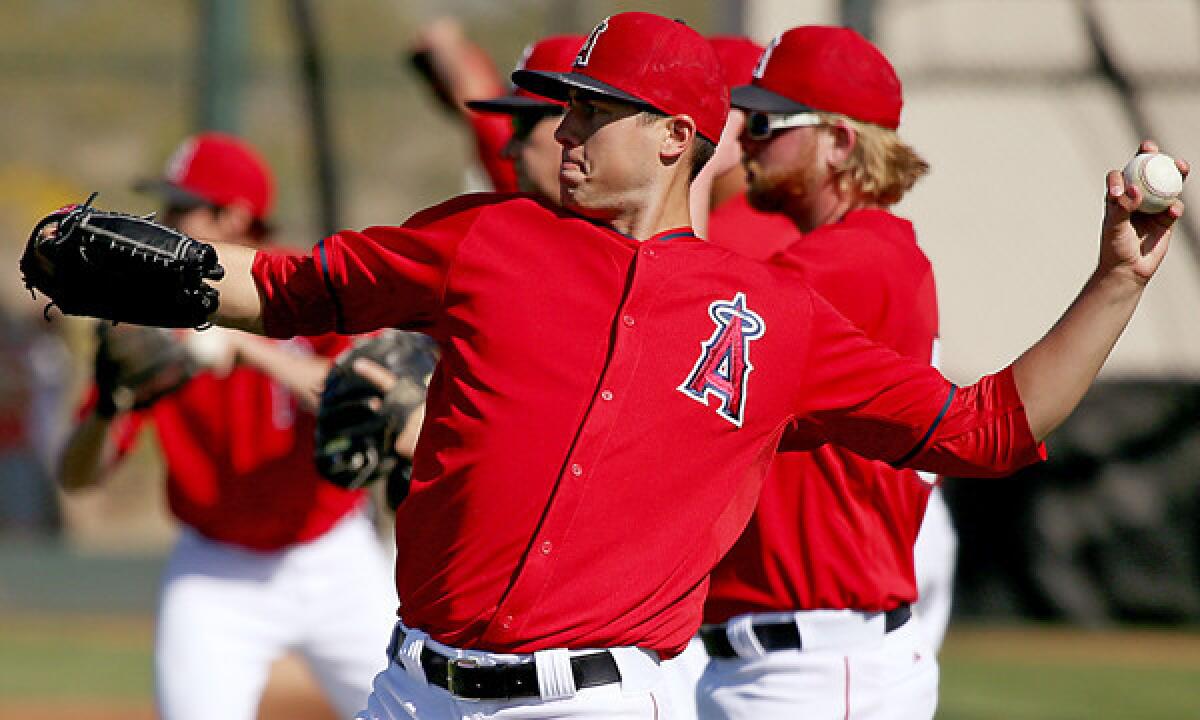Tyler Skaggs is looking to step into starting role with the Angels

- Share via
TEMPE, Ariz. — Tyler Skaggs has the repertoire — a 94-mph fastball, tight curve and changeup — to pitch in the big leagues but has had only a taste of the game at the highest level, going 3-6 with a 5.43 earned run average in 13 starts for Arizona in 2012 and 2013.
The lanky 6-foot-4, 215-pound left-hander believes he is ready for the entree.
“I want to pitch every fifth day in the big leagues and help the team win,” said Skaggs, 22. “I want to take the next step.”
That next step will have more to do with Skaggs’ mental maturation and how he handles adversity than the additional six inches he is striding with his landing foot, a mechanical adjustment that gave his fastball a slight velocity boost this spring.
Any young pitcher can thrive when he has great command, keeps hitters off-balance and off base and has a team that scores a bunch of early runs.
What often separates those who stick in the big leagues from those who slip is what they do with two on and no outs in the early innings of a close game and the heart of the order up.
“The veteran guys do a good job of eliminating external factors that can lead to stress,” Angels catcher Chris Iannetta said. “They’re laser-focused. They think, ‘This is what I need to do to execute this pitch,’ as opposed to, ‘I can’t let these guys score in this situation.’ ”
General Manager Jerry Dipoto, who saved 49 games in eight seasons, remembers that feeling.
“It’s when it’s time to breathe slow,” he said. “The day you will be a consistent and steady big leaguer, and you’re never going to be perfect, is when you’re breathing at the same rate you did when you were pitching in high school, in college, in double-A.”
Dipoto is a strong proponent of Skaggs, having traded for the Santa Monica High product twice, first as Arizona’s interim general manager in the 2010 Dan Haren deal with the Angels, and again as the Angels’ GM in December’s three-team Mark Trumbo trade.
He is convinced Skaggs is ready to turn potential into performance, which is why the Angels have all but handed their fifth rotation spot to Skaggs over Joe Blanton, a veteran with an $8.5-million contract.
“Tyler has the weapons, the belief in himself, the belief of the coaching staff and the front office, and I think he’s pitching with that confidence, of knowing we don’t question him,” Dipoto said.
Skaggs, the 40th overall pick of the 2009 draft, started six games for the Diamondbacks in 2012 and was favored to win the fifth spot in Arizona’s rotation last spring, but he lost out to Patrick Corbin.
“I got a little too fired up,” Skaggs said. “I went out and threw as hard as I could trying to open everyone’s eyes, even though their eyes were already open. I got out of whack. It was a learning experience.”
Skaggs has taken a different approach this spring, working on his fastball command one start, his curve and “still-developing” changeup in another. His results have been mixed — a 4.35 ERA in 101/3 innings, with five earned runs and 12 hits given up, nine strikeouts and four walks.
“I’m focused on getting back to myself mentally and physically,” Skaggs said. “I came in not to open up eyes but to get my work in, go about my business.”
There was concern among Arizona executives late last season when Skaggs’ velocity dipped, but a return to the stride Skaggs used in high school and in the Angels’ farm system has helped restore some steam to his fastball.
“It’s huge,” Skaggs said. “The farther out you get, the harder you throw, and when you use your legs more, it puts less stress on your arm. It’s a small mechanical fix, and it’s worked wonders.”
The switch wasn’t based only on a need for speed; endurance is a factor. Skaggs has not thrown more than 1581/3 innings in any of his five professional seasons, and the Angels would like him to jump to the 180-inning range in 2014.
“By using his legs more, he should be able to maintain his velocity for a lot longer,” pitching coach Mike Butcher said. “He’s been pretty firm so far.”
Skaggs grew up an Angels fan, idolizing another tall left-hander — Chuck Finley — and attending Game 6 of the 2002 World Series as an 11-year-old. Now he’s come “full circle,” as he said, going from the Angels to Arizona and back to the team he rooted for as a kid and that drafted him out of high school.
“It feels good, especially when the most important guy in the organization trades for you twice,” Skaggs said. “It’s a great opportunity. It’s a special thing. It feels like I’m part of the family here.”
Twitter: @MikeDiGiovanna
More to Read
Go beyond the scoreboard
Get the latest on L.A.'s teams in the daily Sports Report newsletter.
You may occasionally receive promotional content from the Los Angeles Times.











